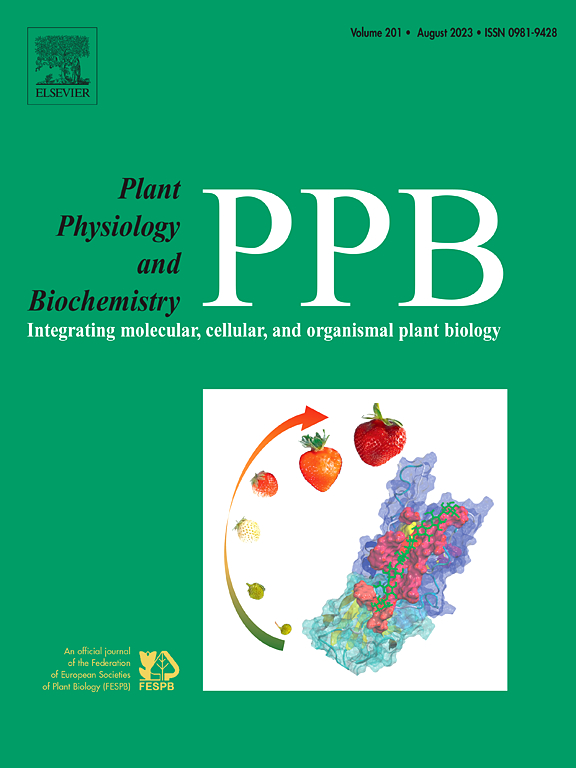Encapsulation of melatonin in pH-responsive β-CD nanosponges for enhanced stability and optimized delivery in agriculture
IF 6.1
2区 生物学
Q1 PLANT SCIENCES
引用次数: 0
Abstract
The current study focuses on the development of a pH-responsive nanosponge designed to enhance the stability and controlled release of phytohormone melatonin. The nanosponge, characterized by disulfide bridges and a stabilizer, allows for regulated release in acidic conditions typical of plant rhizospheres. Four different melatonin to nanosponge weight ratios (1:1, 2:1, 3:1 and 4:1) were prepared and analyzed using Ultra Performance Liquid Chromatography to quantify melatonin loading. The optimized ratio (3:1) was characterized by various techniques, including Zeta potential analysis, FESEM-EDX, FTIR, XRD and DSC. In vitro release studies and photostability tests confirmed the effectiveness of nanosponge in controlled melatonin release and enhanced photostability. Melatonin-loaded nanosponges significantly alleviated salinity stress in tomato plants, enhancing yield and reducing the frequency and dosage of melatonin application. This innovative approach promises improved melatonin stability and efficient agricultural use, offering a novel method to mitigate abiotic stress in plants.
在ph响应β-CD纳米海绵中封装褪黑激素以增强稳定性和优化农业输送
目前的研究重点是开发一种ph响应纳米海绵,旨在提高植物激素褪黑激素的稳定性和控制释放。纳米海绵的特点是二硫桥和稳定剂,可以在植物根际酸性条件下调节释放。制备了四种不同的褪黑素与纳米海绵的重量比(1:1,2:1,3:1和4:1),并使用超高效液相色谱法定量褪黑素的负载。采用Zeta电位分析、FESEM-EDX、FTIR、XRD、DSC等技术对优化后的比例(3:1)进行了表征。体外释放研究和光稳定性试验证实了纳米海绵在控制褪黑激素释放和光稳定性方面的有效性。负载褪黑激素的纳米海绵显著缓解了番茄植株的盐胁迫,提高了产量,减少了褪黑激素的使用频率和用量。这种创新的方法有望提高褪黑激素的稳定性和有效的农业利用,为减轻植物的非生物胁迫提供了一种新的方法。
本文章由计算机程序翻译,如有差异,请以英文原文为准。
求助全文
约1分钟内获得全文
求助全文
来源期刊
CiteScore
11.10
自引率
3.10%
发文量
410
审稿时长
33 days
期刊介绍:
Plant Physiology and Biochemistry publishes original theoretical, experimental and technical contributions in the various fields of plant physiology (biochemistry, physiology, structure, genetics, plant-microbe interactions, etc.) at diverse levels of integration (molecular, subcellular, cellular, organ, whole plant, environmental). Opinions expressed in the journal are the sole responsibility of the authors and publication does not imply the editors'' agreement.
Manuscripts describing molecular-genetic and/or gene expression data that are not integrated with biochemical analysis and/or actual measurements of plant physiological processes are not suitable for PPB. Also "Omics" studies (transcriptomics, proteomics, metabolomics, etc.) reporting descriptive analysis without an element of functional validation assays, will not be considered. Similarly, applied agronomic or phytochemical studies that generate no new, fundamental insights in plant physiological and/or biochemical processes are not suitable for publication in PPB.
Plant Physiology and Biochemistry publishes several types of articles: Reviews, Papers and Short Papers. Articles for Reviews are either invited by the editor or proposed by the authors for the editor''s prior agreement. Reviews should not exceed 40 typewritten pages and Short Papers no more than approximately 8 typewritten pages. The fundamental character of Plant Physiology and Biochemistry remains that of a journal for original results.

 求助内容:
求助内容: 应助结果提醒方式:
应助结果提醒方式:


